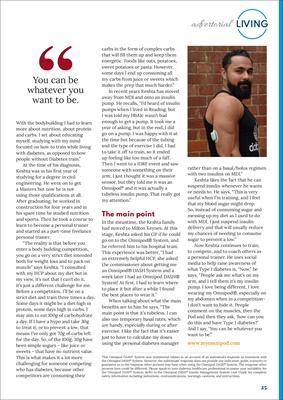
25
LIVING
With the bodybuilding I had to learn
more about nutrition, about protein
and carbs. I set about educating
myself, studying with my mind
focused on how to train while living
with diabetes, as opposed to how
people without Diabetes train."
At the time of his diagnosis,
Keshta was in his first year of
studying for a degree in civil
engineering. He went on to get
a Masters but now he is not
using those qualifications at all.
After graduating, he worked in
construction for four years and in
his spare time he studied nutrition
and sports. Then he took a course to
learn to become a personal trainer
and started as a part-time freelance
personal trainer.
"The reality is that before you
enter a body building competition,
you go on a very strict diet intended
both for weight loss and to pack on
muscle" says Keshta. "I consulted
with my HCP about my diet but in
my view, it's not that I can't do it,
it's just a different challenge for me.
Before a competition, I'll be on a
strict diet and train three times a day.
Some days it might be a diet high in
protein, some days high in carbs. I
may aim to eat 100g of carbohydrate
a day. If I have a hypo and take 30g
to treat it, or to prevent a low, that
means I've only got 70g of carbs left
for the day. So, of the 100g, 30g have
been simple sugars - like juice or
sweets - that have no nutrient value.
This is what makes it a lot more
challenging for someone competing
who has diabetes, because other
competitors are consuming their
carbs in the form of complex carbs
that will fill them up and keep them
energetic. Foods like oats, potatoes,
sweet potatoes or pasta. However,
some days I end up consuming all
my carbs from juice or sweets which
makes the prep that much harder."
In recent years Keshta has moved
away from MDI and onto an insulin
pump. He recalls, "I'd heard of insulin
pumps when I lived in Reading, but
I was told my HbA1c wasn't bad
enough to get a pump. It took me a
year of asking, but in the end, I did
go on a pump. I was happy with it at
the time but because of the tubing
and the type of exercise I did, I had
to take it off to train, so it ended
up feeling like too much of a faff.
Then I went to a JDRF event and saw
someone with something on their
arm; I just thought it was a massive
sensor, but they told me it was an
Omnipod® and it was actually a
tubeless insulin pump. That really got
my attention."
The main point
In the meantime, the Keshta family
had moved to Milton Keynes. At this
stage, Keshta asked his GP if he could
go on to the Omnipod® System, and
he referred him to his hospital team.
This experience was better, "I had
an extremely helpful HCP, she asked
the commissioner about getting me
an Omnipod® DASH System and a
week later I had an Omnipod DASH®
System! At first, I had to learn where
to place it but after a while I found
the best places to wear it."
When talking about what the main
benefits are to him he says, "The
main point is that it's tubeless. I can
also use temporary basal rates, which
are handy, especially during or after
exercise. I like the fact that it's easier
just to have to calculate my doses
using the personal diabetes manager
You can be
whatever you
want to be.
rather than on a basal/bolus regimen
with two insulins on MDI."
Keshta likes the fact that he can
suspend insulin whenever he wants
or needs to. He says, "This is very
useful when I'm training, and I feel
that my blood sugar might drop.
So, instead of consuming sugar and
messing up my diet as I used to do
with MDI, I just suspend insulin
delivery and that will usually reduce
my chances of needing to consume
sugar to prevent a low."
Now Keshta continues to train,
to compete, and to coach others as
a personal trainer. He uses social
media to help raise awareness of
what Type 1 diabetes is. "Now," he
says, "People ask me what's on my
arm, and I tell them it's my insulin
pump. I love being different, I love
wearing my Omnipod®, especially on
my abdomen when in a competition-
I don't want to hide it. People
comment on the muscles, then the
Pod and then they ask, 'how can you
do this and have Type 1 diabetes?'
And I say, 'You can be whatever you
want to be'."
www.myomnipod.com
advertorial
This Omnipod DASH® System user testimonial relates to an account of an individual's response to treatment with
the Omnipod DASH® System. However, the individuals' response does not provide any indication, guide, warranty or
guarantee as to the response other persons may have when using the Omnipod DASH® System. The response other
persons have could be different. Please speak to your diabetes healthcare professional to assess your suitability for
the Omnipod DASH® System. Refer to the Omnipod DASH® Insulin Management System User Guide for complete
safety information including indications, contraindications, warnings, cautions, and instructions.